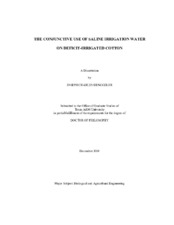| dc.description.abstract | Cotton (Gossypium hirsutum) is able to survive relatively large levels of both water and
salinity stress. The objective of this study was to evaluate cotton lint production and soil
salinization under a conjunctive use strategy using saline water at deficit levels. A three-year
experiment applying irrigation at deficit amounts on cotton was conducted in Pecos, Texas on a
Hoban silty clay loam. Treatments were four irrigation water qualities, conjunctively applied.
Initial irrigation was with water having an electrical conductivity (ECIW) of 4.5 dSm-1,
representing about one-third of the total amount of water applied. Thereafter, treatments were
applied using water of varying ECIW, e.g., 1.5, 4.5, 9.0, and 15.0 dSm-1 for all subsequent
irrigations. Total irrigation plus rain was approximately two-thirds of full water requirements.
Lint yields for the three years averaged 1050, 1008, 809, and 794 kg ha-1, respectively, and
treatment levels did not decline over time. However, the soil salinity levels of the three more
saline treatments increased throughout the test period. Yields declined due to salinity prior to
reaching the published threshold value (Maas and Hoffman, 1977) of ECe = 7.7 dSm-1. Under
the deficit conditions of two-thirds of the full water requirements, the threshold level was
lowered to 4.5 dSm-1. The overall yield loss that resulted from limiting water by one-third was
three times > than the yield loss from even the highest salinity treatment. Relative lint yield was
reduced 3% for each dSm-1 of ECIW. The pre-dawn and solar-noon leaf water potential values
decreased at a rate of 0.026 and 0.042 MPa per dS m-1 of the ECIW, respectively. Study
conclusions were that yields within treatments remained stable for three years. However, the
increase of salinity in the soil profile indicated that long-term viability of using highly saline
water conjunctively is impractical under deficit irrigation conditions. In the short-term,
however, saline water of up to 15.0 dS m-1 can be used at mid-season under deficit conditions on
Hoban silty clay loam soil to secure 75% of the yield level obtained by using high quality water
if a pre-plant irrigation of medium quality water is first applied. | en |


